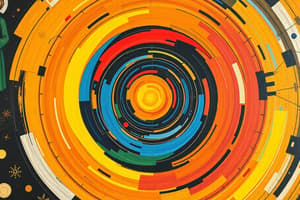Podcast
Questions and Answers
Which aspect of the scientific revolution significantly shaped modern science?
Which aspect of the scientific revolution significantly shaped modern science?
- Prioritizing theological views over empirical evidence.
- Discouraging scientific investigations and experiments.
- Establishing new research fields and a foundation for modern science. (correct)
- Promoting reliance on ancient Greek philosophers without question.
Which of the following best describes the primary motivation of scientists during the scientific revolution?
Which of the following best describes the primary motivation of scientists during the scientific revolution?
- Desire for fame and recognition.
- Fueled by curiosity, critical thinking, and a love for discovery. (correct)
- Compelled by pressure from religious institutions.
- Driven by financial incentives and rewards.
How did the scientific revolution impact existing societal beliefs and understanding of nature?
How did the scientific revolution impact existing societal beliefs and understanding of nature?
- It preserved the views of society about nature.
- It strengthened religious institutions.
- It enforced the views of society about nature.
- It prompted people to reflect and reexamine their beliefs. (correct)
How did Nicolaus Copernicus contribute to the intellectual revolutions in science?
How did Nicolaus Copernicus contribute to the intellectual revolutions in science?
What impact did the religious institutions have on the Copernican model during Copernicus's time?
What impact did the religious institutions have on the Copernican model during Copernicus's time?
What was Charles Darwin's primary contribution to evolutionary thinking?
What was Charles Darwin's primary contribution to evolutionary thinking?
How did Charles Darwin's scientific observations extend beyond plants and animals?
How did Charles Darwin's scientific observations extend beyond plants and animals?
What is the primary method developed by Sigmund Freud to study human's inner life?
What is the primary method developed by Sigmund Freud to study human's inner life?
What makes a location a cradle of civilization?
What makes a location a cradle of civilization?
What characterizes nomadic peoples?
What characterizes nomadic peoples?
What is Mesoamerica known for regarding the agricultural revolution and civilization?
What is Mesoamerica known for regarding the agricultural revolution and civilization?
Which is a characteristic of the Maya Civilization?
Which is a characteristic of the Maya Civilization?
What advanced construction techniques did the Inca civilization use?
What advanced construction techniques did the Inca civilization use?
What was a unique agricultural technique used by the Aztec civilization?
What was a unique agricultural technique used by the Aztec civilization?
Which of the following is NOT a scientific contribution from Ancient India?
Which of the following is NOT a scientific contribution from Ancient India?
Which technological innovation is NOT attributed to ancient China?
Which technological innovation is NOT attributed to ancient China?
What role did seeking knowledge play in early Islamic teaching?
What role did seeking knowledge play in early Islamic teaching?
Which of the following calendars was NOT used by the ancient Egyptians?
Which of the following calendars was NOT used by the ancient Egyptians?
How did indigenous science and technology influence the lives of early Filipinos?
How did indigenous science and technology influence the lives of early Filipinos?
What action did the American colonizers implement that greatly contributed to the development of science and technology in the Philippines?
What action did the American colonizers implement that greatly contributed to the development of science and technology in the Philippines?
Flashcards
Science as an idea
Science as an idea
Ideas, theories, and explanations about the natural world.
Science as an activity
Science as an activity
Systematic and practical investigation of the natural world.
Science as knowledge
Science as knowledge
Deals with learning about the natural and physical world.
Science as a social activity
Science as a social activity
Signup and view all the flashcards
Scientific Revolution
Scientific Revolution
Signup and view all the flashcards
Copernicus' Heliocentric Model
Copernicus' Heliocentric Model
Signup and view all the flashcards
Charles Darwin's Theory
Charles Darwin's Theory
Signup and view all the flashcards
Sigmund Freud's Method
Sigmund Freud's Method
Signup and view all the flashcards
Cradle of Civilization
Cradle of Civilization
Signup and view all the flashcards
Mesoamerica
Mesoamerica
Signup and view all the flashcards
Maya's Time Measurement
Maya's Time Measurement
Signup and view all the flashcards
Maya's Waterways
Maya's Waterways
Signup and view all the flashcards
Inca Textile Arts
Inca Textile Arts
Signup and view all the flashcards
Aztec Value on Education
Aztec Value on Education
Signup and view all the flashcards
Aztec Chocolate Development
Aztec Chocolate Development
Signup and view all the flashcards
Chinampa System
Chinampa System
Signup and view all the flashcards
Indian Innovation
Indian Innovation
Signup and view all the flashcards
Muslim Number Systems
Muslim Number Systems
Signup and view all the flashcards
Egyptian Science Advances
Egyptian Science Advances
Signup and view all the flashcards
Filipino ingenuity
Filipino ingenuity
Signup and view all the flashcards
Study Notes
- Scientific curiosity, critical thinking, and creativity drive scientists when exploring the natural world
- Scientists are often driven by a deep passion to discover things
- Scientific revolution began in the early 16th century and lasted up to the 18th century in Europe
- Period of enlightenment when mathematics, physics, astronomy, biology, and chemistry transformed society’s views of nature
Defining Science
- Science includes ideas, theories, systematic explanations, and observations of the natural and physical world
- Science is a systematic and practical study of the natural and physical world
- Science deals with learning about the natural and physical world
- Science is knowledge and activities done by humans to understand the world better
Contributions of some key people to science
- Nicolaus Copernicus's work significantly changed knowledge about the universe
- Copernicus resembled the Greek ancient philosophers and thinkers
- His ideas were an example of a thought experiment.
- Though judged heretical at the time, Copernicus placed the sun as the centerpiece of the universe
- Copernicus believed that the earth and all the planets orbit the Sun, while the moon orbits the Earth
- Charles Darwin's work changed the world's concept of creation and its evolution
- Darwin's book "The Origin of Species" is regarded as one of the most important works of scientific literature
- Darwin's observational skills extended beyond plants and animals to humans
- Sigmund Freud is a famous figure in the field of psychology
- Freud contributed to the scientific world through the development of psychoanalysis
- For Freud, psychoanalysis is a scientific way to study the human mind and neurotic illness
Cradles of Early Science
- A cradle of civilization is a location and culture where civilization was created independently
- Earliest civilizations began in regions with abundant water
- Mesoamerica is a region where agricultural revolution occurred independently
Mayan Civilization
- Maya Civilization is one of the most dominant indigenous societies of Mesoamerica
- The classic period of Mayan culture lasted from about 250 CE until about 900
- The Maya were known for their works in astronomy.
- The Maya empire reached its peak around the sixth century A.D.
- The Maya excelled at agriculture, pottery, writing, calendars and mathematics
- The Maya built looms for weaving cloth
- The Mayans were skilled in mathematics and created a number system based on the numeral 20
Inca Civilization
- The Incas made advanced scientific ideas considering their limitations as an old civilization
- The Incas invented roads paved with stones and irrigation systems for storing water
- This civilization also developed a calendar with 12 months to mark their religious festivals
- The Incas created the first suspension bridge and quipu, which is a system of knotted ropes to keep records
Aztec Civilization
- The Aztec emphasized education, mandating it regardless of socio-economic class, gender, or age
- The Aztecs also used a type of antispasmodic medication that could prevent muscle spasm and relax muscles
- Chinampa is a form of Aztec technology for agricultural farming, which divided land into rectangular areas that were surrounded by canals
- The Aztecs invented created the canoe, a light narrow boat that was used for travelling in water systems
Science in India
- Indians developed ideas and technologies in astronomy, mathematics, and medicine
- They discovered medicinal properties of plants
- Ayurveda is a system of traditional medicine that originated in ancient India, and is still used today
- The Indians are known for manufacturing iron and in metallurgical works
Science in China
- Chinese civilizations have greatly influenced many of its neighboring countries, and others that belong to the old silk road.
- The first recorded observations of comets, solar eclipses, and supernovae were made in China
- The compass, gunpowder, paper making and printing were among the most important technological advances in China
Science in the Middle East during Islamic Teaching
- Early Islamic teaching encouraged the pursuit of scholarship and science
- Islamic engineering included reservoirs, aqueducts, water wheels, and elaborate systems for irrigation
- Algebra first became a separate field of mathematics in Islam
Science in Ancient Egypt
- The ancient Egyptian civilization contributed to astronomy, mathematics, medicine, and agriculture
- Egyptians used lunar and stellar calendars and had knowledge of geometry
- Egyptians invented metal tools used in their homes and in agriculture
Science in Africa
- Africa has the world's oldest record of human technological achievement, the oldest stone tools in the world.
- Blessed with natural and mineral resources, science emerged in this part of the planet long before the Europeans colonized it
History of Science and Technology in the Philippines
- Pre-Spanish Filipinos used scientific knowledge in planting crops, taking care of animals, and predicting seasons
- They also built houses, irrigations, and tools for everyday life
- Metal Age also had a significant influence on the lives of early Filipinos, who made tools, jewelry, and metal tools have helped in the development of different tools
Science and Technology Under Spanish Colonization
- Spaniards established schools for boys and girls, introducing subjects and disciplines
- Filipinos replicated Spanish technology using indigenous materials
- Medicine and advanced science were introduced in formal colleges and universities
- The Galleon trade brought additional technology and development
Science and Technology Under American Colonization
- The Americans established the public education system, improved engineering works, and improved health conditions
- A modern research university, the University of the Philippines, was established
- Mineral resources were explored, and transportation and communication systems were improved
Science and Technology in the Philippines
- Science and technology may have a significant impact on the lives of the people and in the development of Philippine society
- Areas for future research and projects include alternative energy, mineral resources, disease cures, climate change, food production, and infrastructure development
- Emerging areas of research and innovation include artificial intelligence, renewable energy, biotechnology, space science, and climate change adaptation
Improving Science Education in the Philippines
- The Philippines is trying to improve science education in the country.
- Science education focuses on teaching, learning, and understanding science
- In basic education, science education helps students learn important concepts and facts that are related to everyday life (Carele & Campo; Meador, ; Worth & Grollman, 2003) including important skills such
- The state provides scholarships to encourage more students to pursue science courses.
Science schools in the Philippines
- The Philippine government supports the establishment of science schools in various parts of the country to promote science education
- Examples include the Philippine Science High School System (PSHSS) and Special Science Elementary Schools (SSES) project
- Quezon City Regional Science High School, Manila Science High School, and Central Visayan Institute Foundation are focused institutions to promote science and technology
Studying That Suits You
Use AI to generate personalized quizzes and flashcards to suit your learning preferences.




